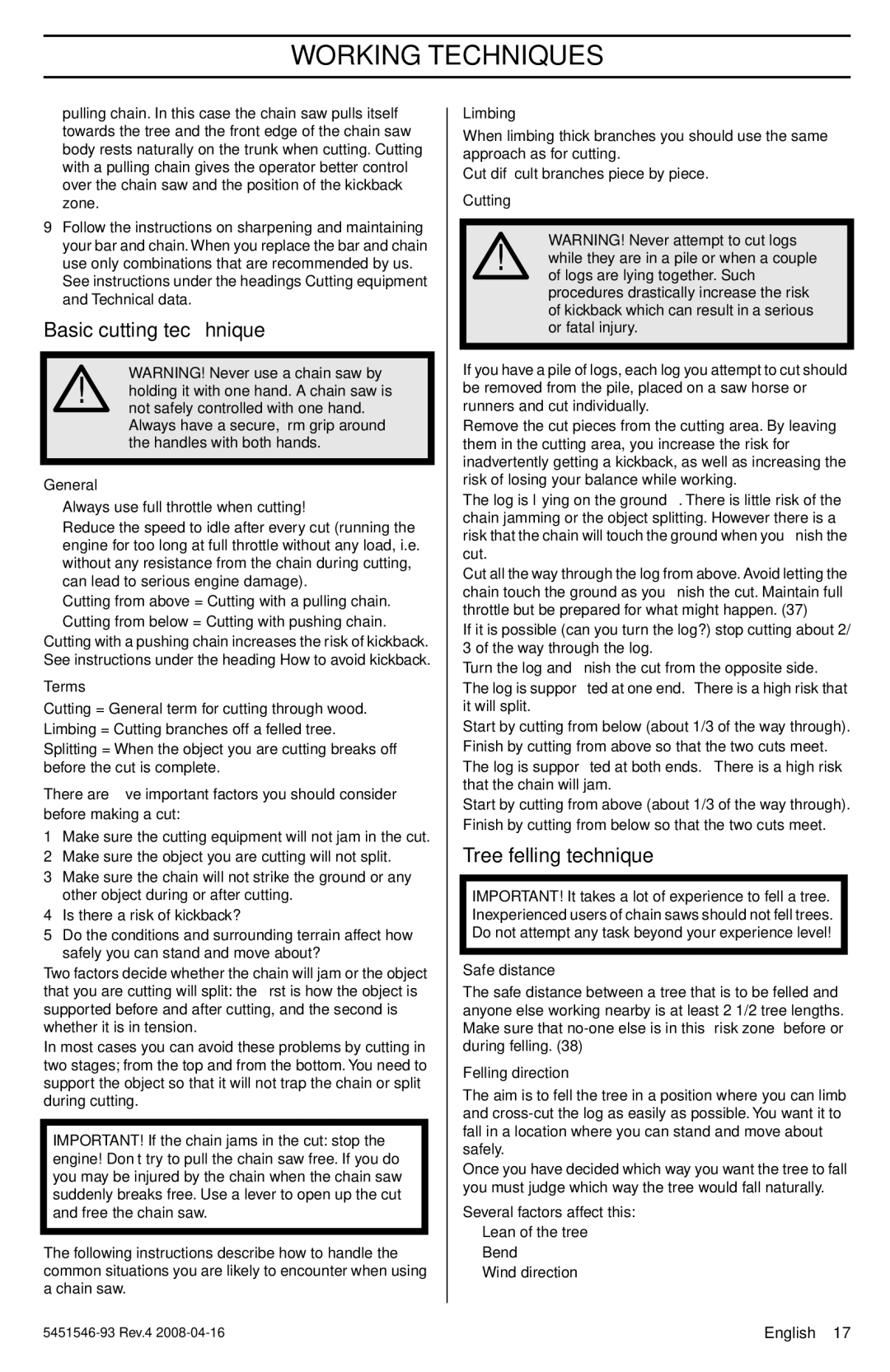pulling chain. In this case the chain saw pulls itself towards the tree and the front edge of the chain saw body rests naturally on the trunk when cutting. Cutting with a pulling chain gives the operator better control over the chain saw and the position of the kickback zone.
9Follow the instructions on sharpening and maintaining your bar and chain.When you replace the bar and chain use only combinations that are recommended by us.
See instructions under the headings Cutting equipment and Technical data.
Basic cutting technique
WARNING! Never use a chain saw by
! holding it with one hand. A chain saw is not safely controlled with one hand. Always have a secure, firm grip around the handles with both hands.
General
•Always use full throttle when cutting!
•Reduce the speed to idle after every cut (running the engine for too long at full throttle without any load, i.e. without any resistance from the chain during cutting, can lead to serious engine damage).
•Cutting from above = Cutting with a pulling chain.
•Cutting from below = Cutting with pushing chain. Cutting with a pushing chain increases the risk of kickback. See instructions under the heading How to avoid kickback.
Terms
Cutting = General term for cutting through wood. Limbing = Cutting branches off a felled tree. Splitting = When the object you are cutting breaks off before the cut is complete.
There are five important factors you should consider before making a cut:
1Make sure the cutting equipment will not jam in the cut.
2 Make sure the object you are cutting will not split.
3 Make sure the chain will not strike the ground or any other object during or after cutting.
4 Is there a risk of kickback?
5 Do the conditions and surrounding terrain affect how safely you can stand and move about?
Two factors decide whether the chain will jam or the object that you are cutting will split: the first is how the object is supported before and after cutting, and the second is whether it is in tension.
In most cases you can avoid these problems by cutting in two stages; from the top and from the bottom. You need to support the object so that it will not trap the chain or split during cutting.
IMPORTANT! If the chain jams in the cut: stop the engine! Don’t try to pull the chain saw free. If you do you may be injured by the chain when the chain saw suddenly breaks free. Use a lever to open up the cut and free the chain saw.
The following instructions describe how to handle the common situations you are likely to encounter when using a chain saw.
Limbing
When limbing thick branches you should use the same approach as for cutting.
Cut difficult branches piece by piece.
Cutting
WARNING! Never attempt to cut logs
! while they are in a pile or when a couple of logs are lying together. Such procedures drastically increase the risk of kickback which can result in a serious or fatal injury.
If you have a pile of logs, each log you attempt to cut should be removed from the pile, placed on a saw horse or runners and cut individually.
Remove the cut pieces from the cutting area. By leaving them in the cutting area, you increase the risk for inadvertently getting a kickback, as well as increasing the risk of losing your balance while working.
The log is lying on the ground. There is little risk of the chain jamming or the object splitting. However there is a risk that the chain will touch the ground when you finish the cut.
Cut all the way through the log from above. Avoid letting the chain touch the ground as you finish the cut. Maintain full throttle but be prepared for what might happen. (37)
If it is possible (can you turn the log?) stop cutting about 2/ 3 of the way through the log.
Turn the log and finish the cut from the opposite side. The log is supported at one end. There is a high risk that it will split.
Start by cutting from below (about 1/3 of the way through). Finish by cutting from above so that the two cuts meet. The log is supported at both ends. There is a high risk that the chain will jam.
Start by cutting from above (about 1/3 of the way through). Finish by cutting from below so that the two cuts meet.
Tree felling technique
IMPORTANT! It takes a lot of experience to fell a tree. Inexperienced users of chain saws should not fell trees. Do not attempt any task beyond your experience level!
Safe distance
The safe distance between a tree that is to be felled and anyone else working nearby is at least 2 1/2 tree lengths. Make sure that no-one else is in this ”risk zone” before or during felling. (38)
Felling direction
The aim is to fell the tree in a position where you can limb and cross-cut the log as easily as possible. You want it to fall in a location where you can stand and move about safely.
Once you have decided which way you want the tree to fall you must judge which way the tree would fall naturally.
Several factors affect this:
•Lean of the tree
•Bend
•Wind direction

